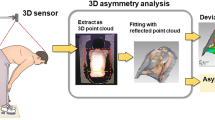Abstract
This paper describes the use of structured splines indices for the clinical monitoring of torso deformity in scoliosis. Structured splines indices are computed from the distribution of points of maximal curvature (dominant points) of an object. The suitability and robustness of the indices for this application is assessed by ascertaining their robustness to inevitable torso shape variations due to sway and breathing and the variability in their values relative to existing clinical measures of deformity. To assess the consistency of these indices with other indices in use for this application, they were used to assess the relative information contents of the front and back of the torso. Results show that structured splines indices are more robust than existing clinical measures for monitoring torso deformity in scoliosis. Results also show that the scoliosis information content ratio of the back torso to the front torso is three to one.




Similar content being viewed by others
References
Ajemba PO (2007) Structured Splines Models: Theory and Application to the Clinical Management of Torso Deformities, PhD Thesis, University of Alberta, Edmonton, Canada
Ajemba PO, Durdle NG, Hill DL, Raso VJ (2007) Classifying torso deformity in scoliosis using orthogonal maps of the torso. Med Biol Eng Comput 45:575–584. doi:10.1007/s11517-007-0192-z
Ajemba PO, Durdle NG, Hill DL, Raso VJ (2007) A torso imaging system for quantifying the deformity associated with scoliosis. IEEE Trans Instrum Meas 56:1520–1526. doi:10.1109/TIM.2007.903592
Ajemba PO, Durdle NG, Raso VJ (2008) Validation of an imaging and analysis system for assessing torso deformities. Comput Biol Med 38(3):294–303. doi:10.1016/j.compbiomed.2007.10.008
Cobb JR (1948) Outline for the study of scoliosis, instructional course lectures. The American academy of orthopedic surgeons 5:261–275
Desroches G, Aubin CE, Sucato DJ, Rivard CH (2007) Simulation of an anterior spine instrumentation in adolescent idiopathic scoliosis using a flexible multi-body model. Med Biol Eng Comput 45(8):759–768. doi:10.1007/s11517-007-0214-x
Duke K, Aubin CE, Dansereau J, Labelle H (2008) Computer simulation for the optimization of patient positioning in spinal deformity instrumentation surgery. Med Biol Eng Comput 46(1):33–41. doi:10.1007/s11517-007-0265-z
Hoke MA (1903) A study of a case of lateral curvature of the spine: report on an operation for the deformity. Am J Orthop Surg 1:168–208
Jaremko JL, Poncet P, Ronsky J, Harder J, Dansereau J, Labelle H et al (2002) Indices of torso asymmetry related to spinal deformity in scoliosis. Clin Biomech (Bristol, Avon) 17:559–568. doi:10.1016/S0268-0033(02)00099-2
Kadoury S, Cheriet F, Laporte C et al (2007) A versatile 3D reconstruction system of the spine and pelvis for clinical assessment of spinal deformities. Med Biol Eng Comput 45(6):591–602. doi:10.1007/s11517-007-0182-1
Levy AR, Goldberg MS, Mayo NE et al (1996) Reducing the lifetime risk of cancer from spinal radiographs among people with adolescent idiopathic scoliosis. Spine 21:1540–1548. doi:10.1097/00007632-199607010-00011
Liu XC, Thometz JG, Lyon RM, Klein J (2001) Functional classification of patients with idiopathic scoliosis assessed by the Quantec system. Spine 26(11):1274–1279. doi:10.1097/00007632-200106010-00020
Pazos V, Cheriet F, Song L, Labelle H, Dansereau J (2005) Accuracy assessment of human trunk surface 3D reconstructions from an optical digitising system. Med Biol Eng Comput 43(1):11–15. doi:10.1007/BF02345117
Raso VJ, Lou E, Hill DL, Mahood JK, Moreau MJ, Durdle NG (1998) Trunk distortion in adolescent idiopathic scoliosis. J Pediatr Orthop 18(3):222–226. doi:10.1097/00004694-199803000-00017
Stokes IAF, Moreland MS (1989) Concordance of back surface asymmetry and spine shape in idiopathic scoliosis. Spine 14:73–78. doi:10.1097/00007632-198901000-00015
Suzuki N, Armstrong GWD, Armstrong J (1981) Application of Moiré topography to spinal deformity. In: Moreland MS, Pope MH, Armstrong GWD (eds) Moiré fringe topography and spinal deformity. Pergamon Press, New York, pp 225–240
Theologis TN, Fairbank JC, Turner-Smith AR, Pantazopoulos T (1997) Early detection of progression in AIS by measurement of changes in back shape with the integrated shape imaging system scanner. Spine 22(11):1223–1227. doi:10.1097/00007632-199706010-00010
Author information
Authors and Affiliations
Corresponding author
Rights and permissions
About this article
Cite this article
Ajemba, P.O., Durdle, N.G. & James Raso, V. Clinical monitoring of torso deformities in scoliosis using structured splines models. Med Biol Eng Comput 46, 1201–1208 (2008). https://doi.org/10.1007/s11517-008-0399-7
Received:
Accepted:
Published:
Issue Date:
DOI: https://doi.org/10.1007/s11517-008-0399-7




